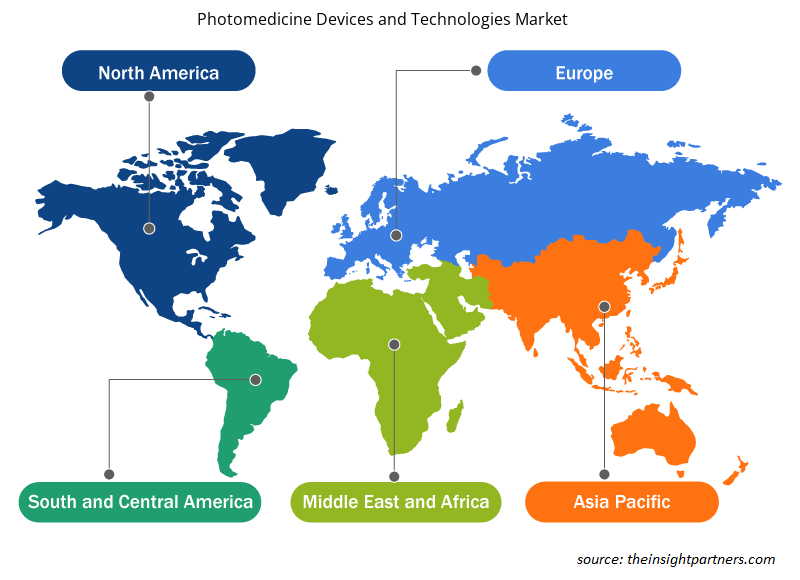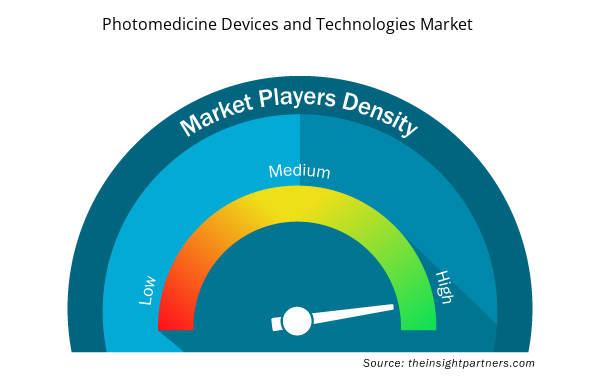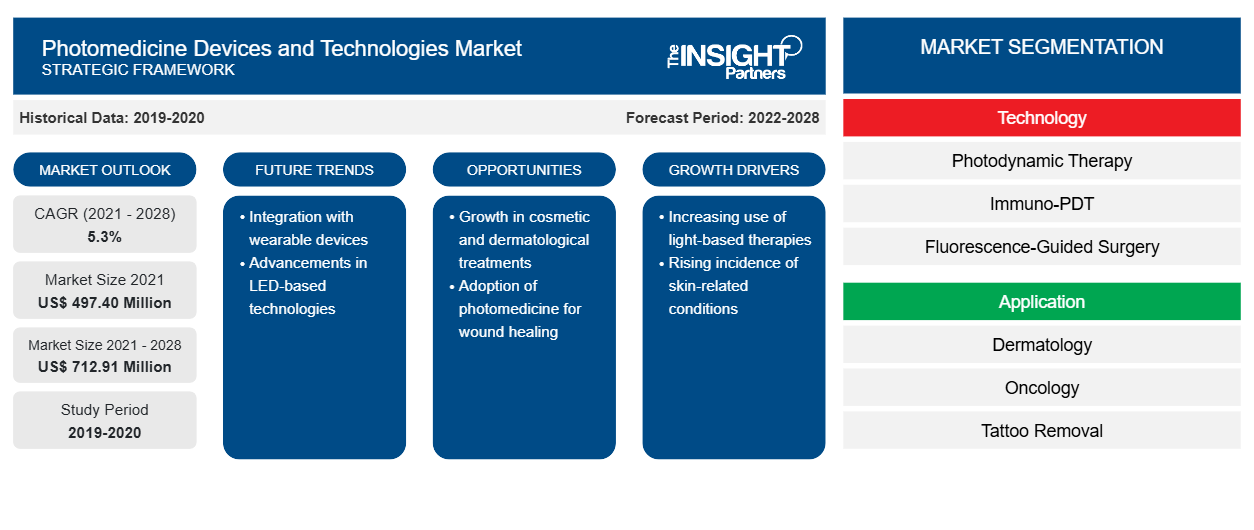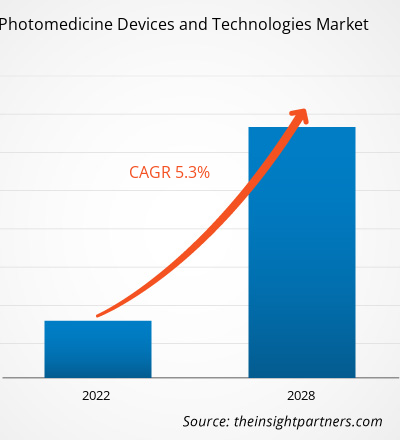Der Markt für Photomedizingeräte und -technologien soll von 497,40 Millionen US-Dollar im Jahr 2021 auf 712,91 Millionen US-Dollar im Jahr 2028 anwachsen; von 2021 bis 2028 wird mit einer durchschnittlichen jährlichen Wachstumsrate von 5,3 % gerechnet.
Photomedizin ist eine medizinische Disziplin, die Photobiologie und Licht zur Heilung von Krankheiten und anderen Beschwerden einsetzt. Bei dieser Behandlung werden Laser, Vollspektrumlicht, dichroitische Lampen, polychromatisches polarisiertes Licht, Leuchtdioden und Leuchtstofflampen eingesetzt, um Menschen bestimmten Wellenlängen des Lichts auszusetzen. Photomedizin ist eine neue Therapieoption für eine Vielzahl von Erkrankungen, die die alte Technik zur Diagnose und Erkennung einer Erkrankung übertroffen hat. Faktoren wie eine breitere Anwendbarkeit der Photomedizin und eine steigende Nachfrage nach minimalinvasiven und nichtinvasiven Therapien kurbeln das Marktwachstum für Photomedizingeräte und -technologien an . Der strenge regulatorische Rahmen für Photomedizintechnologien behindert jedoch das Wachstum des Marktes.
Markteinblicke
Steigende Nachfrage nach minimalinvasiven und nichtinvasiven Therapien fördert das Marktwachstum für photomedizinische Geräte und Technologien
Die Popularität minimalinvasiver medizinischer Verfahren hat in den letzten Jahren zugenommen, da winzige Schnitte erforderlich sind, sich die Patienten schneller erholen und weniger Beschwerden verursachen. Darüber hinaus bieten photomedizinische Verfahren Vorteile wie weniger Schmerzen, weniger Traumata für Muskeln, Nerven, Gewebe und Organe, weniger Blutungen und Narbenbildung sowie minimale Gewebeverletzungen. Laut der American Society of Plastic Surgeons wurden im Jahr 2020 in den USA über 15,6 Millionen minimalinvasive kosmetische Eingriffe durchgeführt. Im Jahr 2020 wurden insgesamt 13.281.235 minimalinvasive kosmetische Eingriffe durchgeführt. Unter den Top 5 der minimalinvasiven kosmetischen Eingriffe hat die Behandlung mit intensivem gepulstem Licht (IPL) die Laser-Haarentfernungsbehandlung abgelöst, wobei im Jahr 2020 über 827.000 IPL-Eingriffe durchgeführt wurden. Laut einem globalen Bericht der International Society of Aesthetic Plastic Surgery (ISAPS) stieg die Zahl der weltweit durchgeführten ästhetischen und kosmetischen Eingriffe von 20.236.901 im Jahr 2014 auf 23.266.374 im Jahr 2018.
Passen Sie diesen Bericht Ihren Anforderungen an
Sie erhalten kostenlos individuelle Anpassungen an jedem Bericht, einschließlich Teilen dieses Berichts oder einer Analyse auf Länderebene, eines Excel-Datenpakets sowie tolle Angebote und Rabatte für Start-ups und Universitäten.
- Holen Sie sich die wichtigsten Markttrends aus diesem Bericht.Dieses KOSTENLOSE Beispiel umfasst eine Datenanalyse von Markttrends bis hin zu Schätzungen und Prognosen.
Technologiebasierte Erkenntnisse
Basierend auf der Technologie ist der Markt für Photomedizingeräte und -technologien in Photodynamische Therapie (PDT), Immuno-PDT (Photoimmuntherapien), fluoreszenzgeführte Chirurgie, Photodynamische Diagnostik, Photobiomodulation (Laserlicht) und andere Technologien unterteilt. Das Segment der photodynamischen Therapie hatte 2021 den größten Marktanteil und wird im Prognosezeitraum voraussichtlich die höchste durchschnittliche jährliche Wachstumsrate verzeichnen.
Anwendungsbasierte Erkenntnisse
Basierend auf der Anwendung ist der Markt für Photomedizingeräte und -technologien in Ästhetik und Dermatologie, Onkologie, Augenheilkunde, Neurologie, Schmerztherapie, Wundheilung und andere Anwendungen unterteilt. Der Markt für das Segment Ästhetik und Dermatologie ist weiter in Haarentfernung, Tattooentfernung, Hauterneuerung und andere Anwendungen unterteilt. Das Segment Ästhetik und Dermatologie hatte 2021 den größten Marktanteil und es wird erwartet, dass dasselbe Segment im Prognosezeitraum die höchste durchschnittliche jährliche Wachstumsrate (CAGR) auf dem Markt verzeichnet.
Verschiedene auf dem Markt für Photomedizingeräte und -technologien tätige Unternehmen verfolgen Strategien wie Produkteinführungen, Fusionen und Übernahmen, Kooperationen, Produktinnovationen und die Erweiterung ihres Produktportfolios, um ihre Präsenz weltweit auszubauen, ihren Markennamen zu wahren und die wachsende Nachfrage der Endverbraucher zu erfüllen.
Photomedizinische Geräte und Technologien
Regionale Einblicke in den Markt für photomedizinische Geräte und Technologien
Die regionalen Trends und Faktoren, die den Markt für Photomedizingeräte und -technologien während des gesamten Prognosezeitraums beeinflussen, wurden von den Analysten von Insight Partners ausführlich erläutert. In diesem Abschnitt werden auch die Marktsegmente und die Geografie von Photomedizingeräten und -technologien in Nordamerika, Europa, im asiatisch-pazifischen Raum, im Nahen Osten und Afrika sowie in Süd- und Mittelamerika erörtert.

- Erhalten Sie regionale Daten zum Markt für photomedizinische Geräte und Technologien
Umfang des Marktberichts zu photomedizinischen Geräten und Technologien
| Berichtsattribut | Details |
|---|---|
| Marktgröße im Jahr 2021 | 497,40 Millionen US-Dollar |
| Marktgröße bis 2028 | 712,91 Millionen US-Dollar |
| Globale CAGR (2021 - 2028) | 5,3 % |
| Historische Daten | 2019-2020 |
| Prognosezeitraum | 2022–2028 |
| Abgedeckte Segmente | Nach Technologie
|
| Abgedeckte Regionen und Länder | Nordamerika
|
| Marktführer und wichtige Unternehmensprofile |
|
Dichte der Marktteilnehmer für photomedizinische Geräte und Technologien: Die Auswirkungen auf die Geschäftsdynamik verstehen
Der Markt für Photomedizingeräte und -technologien wächst rasant. Dies wird durch die steigende Nachfrage der Endnutzer aufgrund von Faktoren wie sich entwickelnden Verbraucherpräferenzen, technologischen Fortschritten und einem größeren Bewusstsein für die Vorteile des Produkts vorangetrieben. Mit der steigenden Nachfrage erweitern Unternehmen ihr Angebot, entwickeln Innovationen, um die Bedürfnisse der Verbraucher zu erfüllen, und nutzen neue Trends, was das Marktwachstum weiter ankurbelt.
Die Marktteilnehmerdichte bezieht sich auf die Verteilung von Firmen oder Unternehmen, die in einem bestimmten Markt oder einer bestimmten Branche tätig sind. Sie gibt an, wie viele Wettbewerber (Marktteilnehmer) in einem bestimmten Marktraum im Verhältnis zu seiner Größe oder seinem gesamten Marktwert präsent sind.
Die wichtigsten auf dem Markt für photomedizinische Geräte und Technologien tätigen Unternehmen sind:
- Alma Lasers
- Beurer GmbH
- Biolitec AG
- Lumenis
- Quantel Medical
Haftungsausschluss : Die oben aufgeführten Unternehmen sind nicht in einer bestimmten Reihenfolge aufgeführt.

- Erhalten Sie einen Überblick über die wichtigsten Akteure auf dem Markt für Photomedizingeräte und -technologien
Markt für photomedizinische Geräte und Technologien – nach Technologie
- Photodynamische Therapie (PDT)
- Immun-PDT (Photoimmuntherapien)
- Fluoreszenzgestützte Chirurgie
- Photodynamische Diagnostik
- Photobiomodulation (Laserlicht)
- Andere Technologien
Markt für photomedizinische Geräte und Technologien – nach Anwendung
- Ästhetik und Dermatologie
- Haarentfernung
- Tattooentfernung
- Hauterneuerung
- Andere Anwendungen
- Onkologie
- Augenheilkunde
- Neurologie
- Schmerztherapie
- Wundheilung
- Andere Anwendungen
Markt für photomedizinische Geräte und Technologien – nach Geografie
- Nordamerika
- UNS
- Kanada
- Mexiko
- Europa
- Frankreich
- Deutschland
- Italien
- Vereinigtes Königreich
- Spanien
- Restliches Europa
- Asien-Pazifik (APAC)
- China
- Indien
- Südkorea
- Japan
- Australien
- Restlicher Asien-Pazifik-Raum
- Naher Osten und Afrika (MEA)
- Südafrika
- Saudi-Arabien
- Vereinigte Arabische Emirate
- Restlicher Naher Osten und Afrika
- Südamerika (SAM)
- Brasilien
- Argentinien
- Restliches Süd- und Mittelamerika
Firmenprofile
- Alma Lasers
- Beurer GmbH
- Biolitec AG
- Lumenis
- Quantel Medical
- THOR Photomedicine Ltd
- Verilux Inc
- Candela Medizin
- KONINKLIJKE PHILIPS NV
- Iridex Corporation
- Historische Analyse (2 Jahre), Basisjahr, Prognose (7 Jahre) mit CAGR
- PEST- und SWOT-Analyse
- Marktgröße Wert/Volumen – Global, Regional, Land
- Branche und Wettbewerbsumfeld
- Excel-Datensatz



Report Coverage
Revenue forecast, Company Analysis, Industry landscape, Growth factors, and Trends

Segment Covered
This text is related
to segments covered.

Regional Scope
North America, Europe, Asia Pacific, Middle East & Africa, South & Central America

Country Scope
This text is related
to country scope.
Häufig gestellte Fragen
Global photomedicine devices and technologies market is segmented by region into North America, Europe, Asia Pacific, Middle East & Africa and South & Central America. In North America, the U.S. is the largest market for photomedicine devices and technologies. The US is estimated to hold the largest share in the photomedicine devices and technologies market during the forecast period. Whereas, Asia Pacific is the fastest growing region during the forecast period with highest CAGR rate of 6.1%. The growth of Asia Pacific photomedicine devices and technologies market is owing to, increasing burden of chronic diseases such as cancer, rise in demand for minimally invasive surgical procedures and growing adoption of photomedicine.
The photomedicine devices and technologies market majorly consists of the players such as Alma Lasers, Beurer GmbH., Biolitec AG, Lumenis, Quantel Medical, THOR Photomedicine Ltd, Verilux Inc, Candela Medical, KONINKLIJKE PHILIPS N.V., and Iridex Corporation, among others
The photodynamic therapy segment dominated the global photomedicine devices and technologies market and held the largest revenue share of 24.82% in 2021.
The aesthetics and dermatology segment dominated the global photomedicine devices and technologies market and accounted for the largest revenue share of 27.72% in 2021.
Photomedicine is a discipline of medicine that uses photobiology and light to cure diseases and other medical conditions. Photomedicine is the use of lasers, full-spectrum light, dichroic lamps, polychromatic polarized light, light-emitting diodes, and fluorescent lamps to expose people to specific wavelengths of light. Photomedicine is a new therapy option for a variety of disorders that has outperformed the old technique of diagnosing and detecting a condition.
Key factors that are driving the growth of this market are wider applicability of photomedicine and rise in demand for minimally invasive and non-invasive therapies.
Trends and growth analysis reports related to Life Sciences : READ MORE..
The List of Companies - Photomedicine Devices and Technologies Market
- Alma Lasers
- Beurer GmbH
- Biolitec AG
- Lumenis
- Quantel Medical
- THOR Photomedicine Ltd
- Verilux Inc
- Candela Medical
- KONINKLIJKE PHILIPS N.V
- Iridex Corporation
The Insight Partners performs research in 4 major stages: Data Collection & Secondary Research, Primary Research, Data Analysis and Data Triangulation & Final Review.
- Data Collection and Secondary Research:
As a market research and consulting firm operating from a decade, we have published and advised several client across the globe. First step for any study will start with an assessment of currently available data and insights from existing reports. Further, historical and current market information is collected from Investor Presentations, Annual Reports, SEC Filings, etc., and other information related to company’s performance and market positioning are gathered from Paid Databases (Factiva, Hoovers, and Reuters) and various other publications available in public domain.
Several associations trade associates, technical forums, institutes, societies and organization are accessed to gain technical as well as market related insights through their publications such as research papers, blogs and press releases related to the studies are referred to get cues about the market. Further, white papers, journals, magazines, and other news articles published in last 3 years are scrutinized and analyzed to understand the current market trends.
- Primary Research:
The primarily interview analysis comprise of data obtained from industry participants interview and answers to survey questions gathered by in-house primary team.
For primary research, interviews are conducted with industry experts/CEOs/Marketing Managers/VPs/Subject Matter Experts from both demand and supply side to get a 360-degree view of the market. The primary team conducts several interviews based on the complexity of the markets to understand the various market trends and dynamics which makes research more credible and precise.
A typical research interview fulfils the following functions:
- Provides first-hand information on the market size, market trends, growth trends, competitive landscape, and outlook
- Validates and strengthens in-house secondary research findings
- Develops the analysis team’s expertise and market understanding
Primary research involves email interactions and telephone interviews for each market, category, segment, and sub-segment across geographies. The participants who typically take part in such a process include, but are not limited to:
- Industry participants: VPs, business development managers, market intelligence managers and national sales managers
- Outside experts: Valuation experts, research analysts and key opinion leaders specializing in the electronics and semiconductor industry.
Below is the breakup of our primary respondents by company, designation, and region:

Once we receive the confirmation from primary research sources or primary respondents, we finalize the base year market estimation and forecast the data as per the macroeconomic and microeconomic factors assessed during data collection.
- Data Analysis:
Once data is validated through both secondary as well as primary respondents, we finalize the market estimations by hypothesis formulation and factor analysis at regional and country level.
- Macro-Economic Factor Analysis:
We analyse macroeconomic indicators such the gross domestic product (GDP), increase in the demand for goods and services across industries, technological advancement, regional economic growth, governmental policies, the influence of COVID-19, PEST analysis, and other aspects. This analysis aids in setting benchmarks for various nations/regions and approximating market splits. Additionally, the general trend of the aforementioned components aid in determining the market's development possibilities.
- Country Level Data:
Various factors that are especially aligned to the country are taken into account to determine the market size for a certain area and country, including the presence of vendors, such as headquarters and offices, the country's GDP, demand patterns, and industry growth. To comprehend the market dynamics for the nation, a number of growth variables, inhibitors, application areas, and current market trends are researched. The aforementioned elements aid in determining the country's overall market's growth potential.
- Company Profile:
The “Table of Contents” is formulated by listing and analyzing more than 25 - 30 companies operating in the market ecosystem across geographies. However, we profile only 10 companies as a standard practice in our syndicate reports. These 10 companies comprise leading, emerging, and regional players. Nonetheless, our analysis is not restricted to the 10 listed companies, we also analyze other companies present in the market to develop a holistic view and understand the prevailing trends. The “Company Profiles” section in the report covers key facts, business description, products & services, financial information, SWOT analysis, and key developments. The financial information presented is extracted from the annual reports and official documents of the publicly listed companies. Upon collecting the information for the sections of respective companies, we verify them via various primary sources and then compile the data in respective company profiles. The company level information helps us in deriving the base number as well as in forecasting the market size.
- Developing Base Number:
Aggregation of sales statistics (2020-2022) and macro-economic factor, and other secondary and primary research insights are utilized to arrive at base number and related market shares for 2022. The data gaps are identified in this step and relevant market data is analyzed, collected from paid primary interviews or databases. On finalizing the base year market size, forecasts are developed on the basis of macro-economic, industry and market growth factors and company level analysis.
- Data Triangulation and Final Review:
The market findings and base year market size calculations are validated from supply as well as demand side. Demand side validations are based on macro-economic factor analysis and benchmarks for respective regions and countries. In case of supply side validations, revenues of major companies are estimated (in case not available) based on industry benchmark, approximate number of employees, product portfolio, and primary interviews revenues are gathered. Further revenue from target product/service segment is assessed to avoid overshooting of market statistics. In case of heavy deviations between supply and demand side values, all thes steps are repeated to achieve synchronization.
We follow an iterative model, wherein we share our research findings with Subject Matter Experts (SME’s) and Key Opinion Leaders (KOLs) until consensus view of the market is not formulated – this model negates any drastic deviation in the opinions of experts. Only validated and universally acceptable research findings are quoted in our reports.
We have important check points that we use to validate our research findings – which we call – data triangulation, where we validate the information, we generate from secondary sources with primary interviews and then we re-validate with our internal data bases and Subject matter experts. This comprehensive model enables us to deliver high quality, reliable data in shortest possible time.


 Holen Sie sich ein kostenloses Muster für diesen Bericht
Holen Sie sich ein kostenloses Muster für diesen Bericht